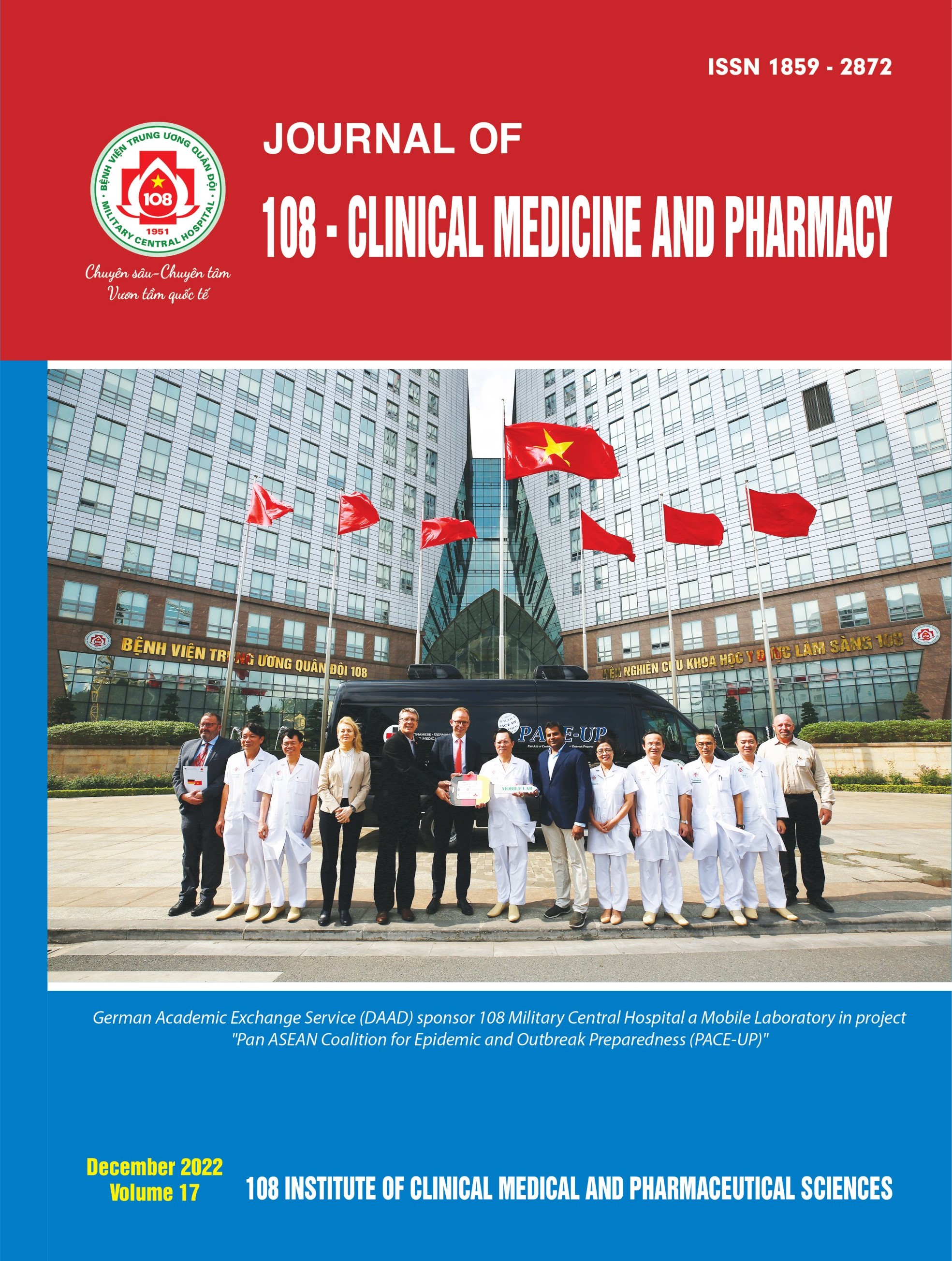Clinical characteristics, brain computerized tomography scan and surgical outcome in elderly patients with chronic subdural hematoma
Main Article Content
Tóm tắt
Objective: To determine clinical characteristics, computer tomography brain imaging, and surgical outcome for elderly patients with chronic subdural hematoma (CSDH). Subject and method: A cross-sectional, descriptive, and retrospective study was conducted on 74 elderly patients diagnosed with CSDH and operated at 108 Military Central Hospital from June 2020 to June 2021. Result: Mean age was 75.2 years; male/female ratio was 3.93/1, the most common cause was traumatic brain injury (49%). The common presenting symptoms of CSDH were altered mental state (70.9%) and headache (68.9%), followed by cognitive impairment (54.1%), hemiparesis (21.6%), hematoma maximal thickness and midline shift were associated with a higher rate of hemiparesis in CSDH patients (p<0.05); The percentage of patients with GCS score ≥ 13 was 90.5%. The portion of unilateral on the brain CT was 78.4%. The most common densities of CSDH obtained from CT imaging was isodense (accounting for 54.0%); followed by hypodense (20.3%), high-density (17.6%), and mixed-density (8.1%); The most common complication of burr hole technique was pneumocephalus (accounting for 8.1%); recurrence of CSDH (5.4%). The Glasgow outcome scale (GOS) 4-5 was 89.7% within 3 months. Conclusion: Chronic subdural hematoma was one of the most common diseases in neurosurgery. The burr hole drainage technique was safe and effective.
Article Details
Các tài liệu tham khảo
2. Adhiyaman V, Chattopadhyay I, Irshad F et al (2017) Increasing incidence of chronic subdural haematoma in the elderly. International Journal of Medicine 110(6): 375-378.
3. Berghauser Pont LM, Dammers R, Schouten JW et al (2002) Clinical factors associated with outcome in chronic subdural hematoma: a retrospective cohort study of patients on preoperative corticosteroid therapy. Neurosurg Focus 70: 873-880.
4. Cheng SY, Chang CK, Chen SJ et al (2014) Chronic subdural hematoma in elderly taiwan patients: A retrospective analysis of 342 surgical cases. International Journal of Gerontology 8(1): 37-41.
5. Gelabert-González M, Iglesias-Pais M, García-Allut A, MartínezRumbo R (2005) Chronic subdural haematoma: Surgical treatment and outcome in 1000 cases. Clin Neurol Neurosurg 107(3): 223-229. doi: 10.1016/j.clineuro.2004.09.015.
6. Haldrup M, Ketharanathan B, Debrabant M (2020) Embolization of the middle meningeal artery in patients with chronic subdural hematoma a systematic review and meta-analysis. Acta Neurochirurgica 162: 777-784.
7. Ivamoto HS, Lemos HP, Atallah AN (2016) Surgical treatments for chronic subdural hematomas: A comprehensive systematic review. World Neurosurg 86: 399-418.
8. Kitya D, Punchak M, Abdelgadir J et al (2018) Clinical presentation, management, and outcomes of chronic subdural hematoma at Mbarara Regional Referral Hospital. Neurosurg Focus 45(4): 7.
9. Motiei-Langroudi R, Alterman Ron L, Stippler M et al (2019) Factors influencing the presence of hemiparesis in chronic subdural hematoma. J Neurosurg 131(6): 1926-1930.
10. Motiei-Langroudi R, Stippler M, Shi S et al (2018) Factors predicting reoperation of chronic subdural hematoma following primary surgical evacuation. J Neurosurg 129(5): 1143-1150.
11. Park HR, Lee KS, Shim JJ et al (2013) Multiple densities of the chronic subdural hematoma in CT scans. J Korean Neurosurg Soc 54(1): 38-41.
12. Rauhala M, Luoto TM, Huhtala H et al (2019) The incidence of chronic subdural hematomas from 1990 to 2015 in a defined Finnish population. J Neurosurg 22: 1147-1157.
13. Shapey J, Glancz LJ, Brennan PM (2016) Chronic subdural haematoma in the elderly: Is it time for a new paradigm in management?. Curr Geri Rep 5: 71-77.
14. Tsai TH, Lieu AS, Hwang SL et al (2010) A comparative study of the patients with bilateral or unilateral chronic subdural hematoma: precipitating factors and postoperative outcomes. J Trauma 68(3): 517-575.
15. Zolfaghari S, Bartek J, Strom I et al (2021) Burr hole craniostomy versus minicraniotomy in chronic subdural hematoma: A comparative cohort study. Acta Neurochirurgica 163(11): 3217-3223
 ISSN: 1859 - 2872
ISSN: 1859 - 2872
